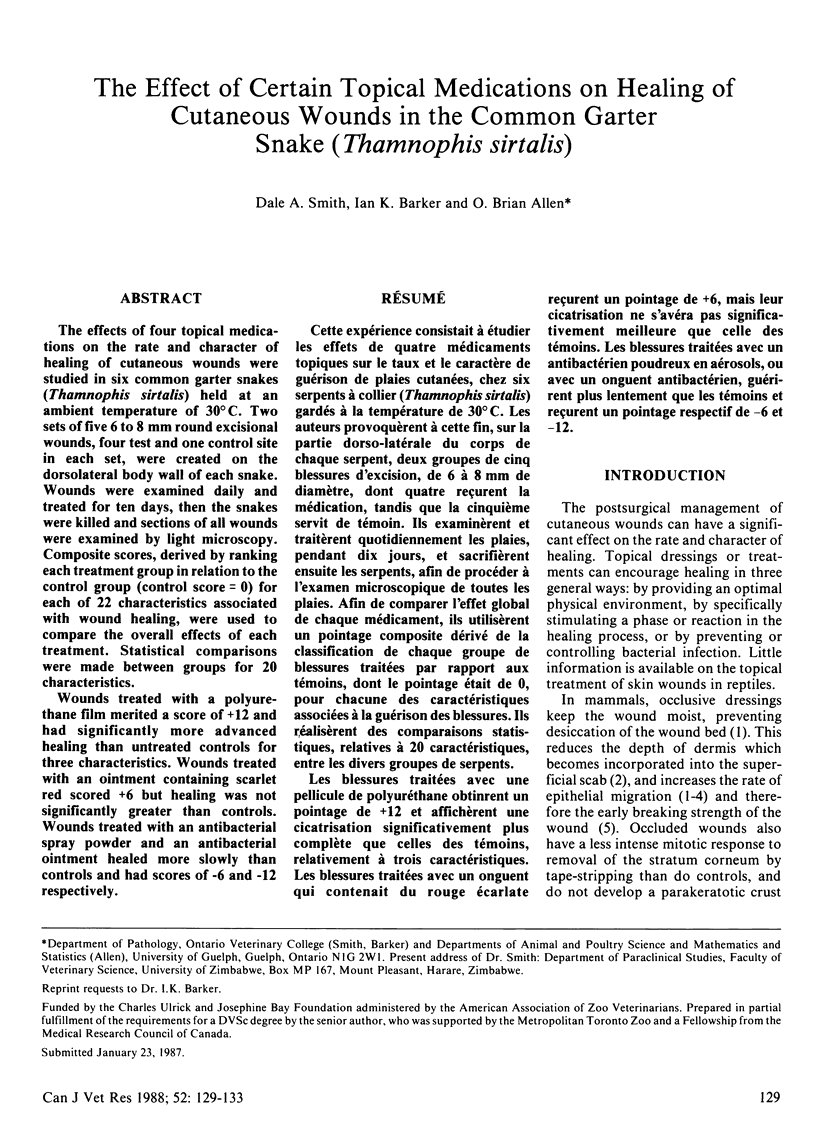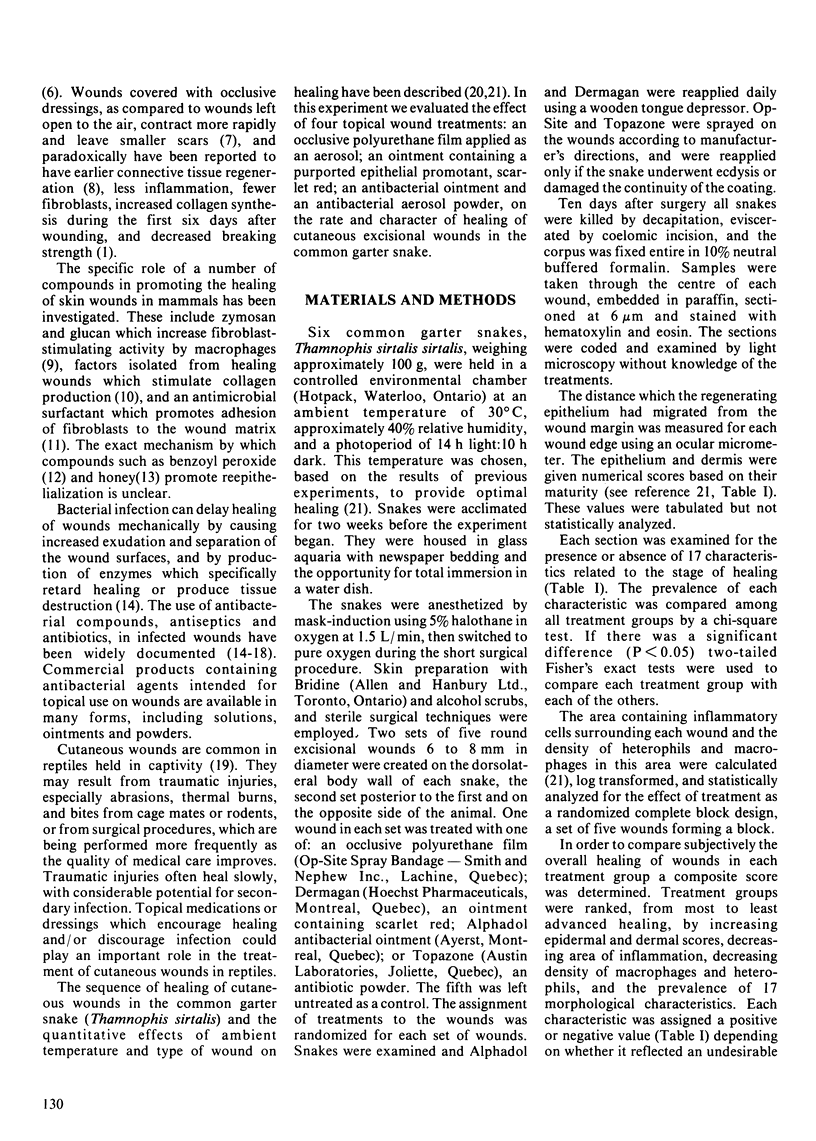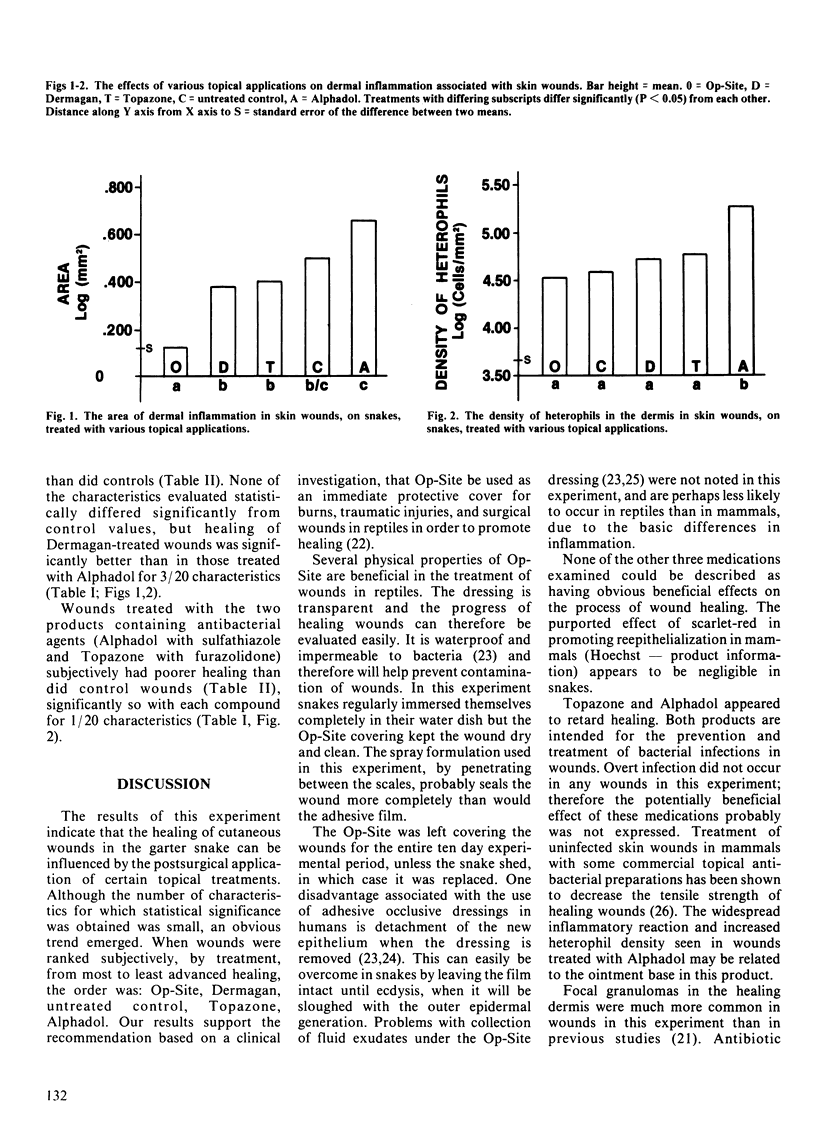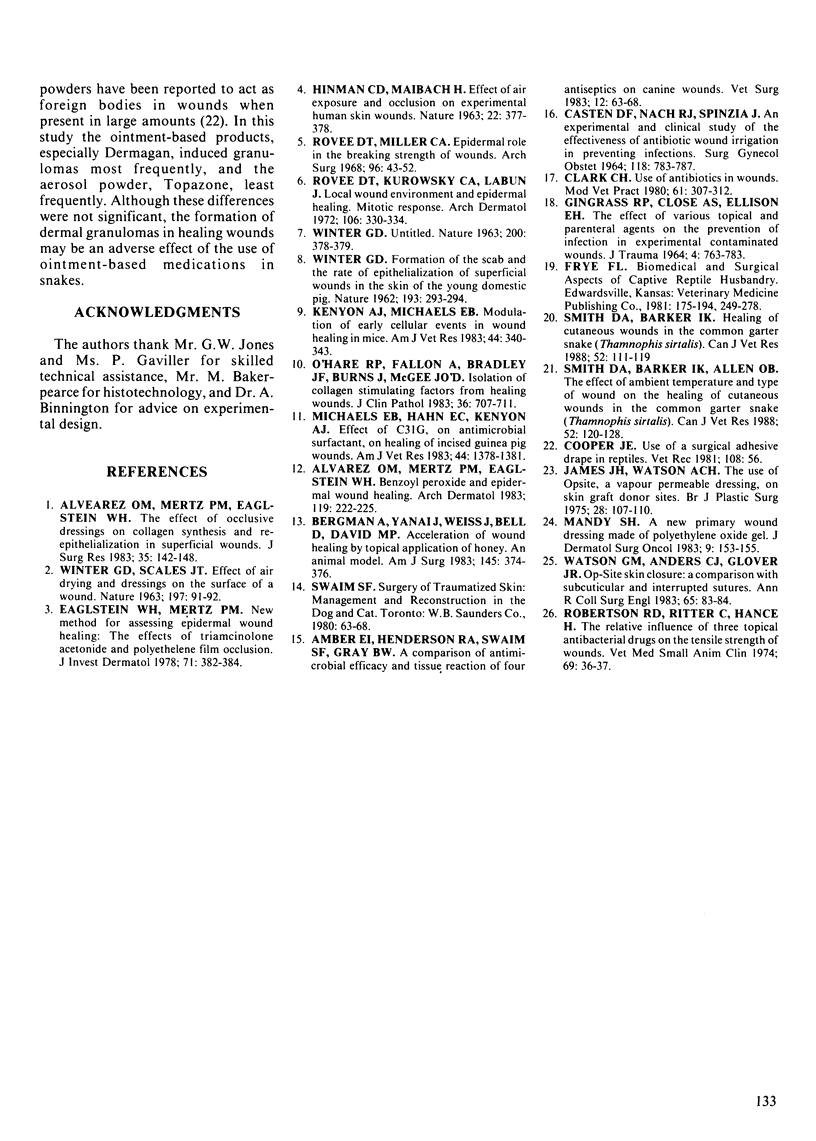Abstract
The effects of four topical medications on the rate and character of healing of cutaneous wounds were studied in six common garter snakes (Thamnophis sirtalis) held at an ambient temperature of 30 degrees C. Two sets of five 6 to 8 mm round excisional wounds, four test and one control site in each set, were created on the dorsolateral body wall of each snake. Wounds were examined daily and treated for ten days, then the snakes were killed and sections of all wounds were examined by light microscopy. Composite scores, derived by ranking each treatment group in relation to the control group (control score = 0) for each of 22 characteristics associated with wound healing, were used to compare the overall effects of each treatment. Statistical comparisons were made between groups for 20 characteristics. Wounds treated with a polyurethane film merited a score of +12 and had significantly more advanced healing than untreated controls for three characteristics. Wounds treated with an ointment containing scarlet red scored +6 but healing was not significantly greater than controls. Wounds treated with an antibacterial spray powder and an antibacterial ointment healed more slowly than controls and had scores of -6 and -12 respectively.
Full text
PDF




Selected References
These references are in PubMed. This may not be the complete list of references from this article.
- Alvarez O. M., Mertz P. M., Eaglstein W. H. Benzoyl peroxide and epidermal wound healing. Arch Dermatol. 1983 Mar;119(3):222–225. [PubMed] [Google Scholar]
- Alvarez O. M., Mertz P. M., Eaglstein W. H. The effect of occlusive dressings on collagen synthesis and re-epithelialization in superficial wounds. J Surg Res. 1983 Aug;35(2):142–148. doi: 10.1016/0022-4804(83)90136-1. [DOI] [PubMed] [Google Scholar]
- Bergman A., Yanai J., Weiss J., Bell D., David M. P. Acceleration of wound healing by topical application of honey. An animal model. Am J Surg. 1983 Mar;145(3):374–376. doi: 10.1016/0002-9610(83)90204-0. [DOI] [PubMed] [Google Scholar]
- CASTEN D. F., NACH R. J., SPINZIA J. AN EXPERIMENTAL AND CLINICAL STUDY OF THE EFFECTIVENESS OF ANTIBIOTIC WOUND IRRIGATION IN PREVENTING INFECTION. Surg Gynecol Obstet. 1964 Apr;118:783–787. [PubMed] [Google Scholar]
- Clark C. H. Use of antibiotics in wounds. Mod Vet Pract. 1980 Apr;61(4):307–312. [PubMed] [Google Scholar]
- Cooper J. E. Use of a surgical adhesive drape in reptiles. Vet Rec. 1981 Jan 17;108(3):56–56. doi: 10.1136/vr.108.3.56. [DOI] [PubMed] [Google Scholar]
- Eaglstein W. H., Mertz P. M. New methods for assessing epidermal wound healing: the effects of triamcinolone acetonide and polyethelene film occlusion. J Invest Dermatol. 1978 Dec;71(6):382–384. doi: 10.1111/1523-1747.ep12556814. [DOI] [PubMed] [Google Scholar]
- GINGRASS R. P., CLOSE A. S., ELLISON E. H. THE EFFECT OF VARIOUS TOPICAL AND PARENTERAL AGENTS ON THE PREVENTION OF INFECTION IN EXPERIMENTAL CONTAMINATED WOUNDS. J Trauma. 1964 Nov;4:763–783. doi: 10.1097/00005373-196411000-00004. [DOI] [PubMed] [Google Scholar]
- HINMAN C. D., MAIBACH H. EFFECT OF AIR EXPOSURE AND OCCLUSION ON EXPERIMENTAL HUMAN SKIN WOUNDS. Nature. 1963 Oct 26;200:377–378. doi: 10.1038/200377a0. [DOI] [PubMed] [Google Scholar]
- James J. H., Watson A. C. The use of Opsite, a vapour permeable dressing, on skin graft donor sites. Br J Plast Surg. 1975 Apr;28(2):107–110. [PubMed] [Google Scholar]
- Kenyon A. J., Michaels E. B. Modulation of early cellular events in wound healing in mice. Am J Vet Res. 1983 Feb;44(2):340–343. [PubMed] [Google Scholar]
- Mandy S. H. A new primary wound dressing made of polyethylene oxide gel. J Dermatol Surg Oncol. 1983 Feb;9(2):153–155. doi: 10.1111/j.1524-4725.1983.tb00778.x. [DOI] [PubMed] [Google Scholar]
- Michaels E. B., Hahn E. C., Kenyon A. J. Effect of C31G, an antimicrobial surfactant, on healing of incised guinea pig wounds. Am J Vet Res. 1983 Jul;44(7):1378–1381. [PubMed] [Google Scholar]
- O'Hare R. P., Fallon A., Bradley J. F., Burns J., McGee J. O. Isolation of collagen stimulating factors from healing wounds. J Clin Pathol. 1983 Jun;36(6):707–711. doi: 10.1136/jcp.36.6.707. [DOI] [PMC free article] [PubMed] [Google Scholar]
- Robertson R. D., Ritter C., Hance H. The relative influence of three topical antibacterial drugs on the tensile strength of wounds. Vet Med Small Anim Clin. 1974 Jan;69(1):36–37. [PubMed] [Google Scholar]
- Rovee D. T., Kurowsky C. A., Labun J. Local wound environment and epidermal healing. Mitotic response. Arch Dermatol. 1972 Sep;106(3):330–334. [PubMed] [Google Scholar]
- Rovee D. T., Miller C. A. Epidermal role in the breaking strength of wounds. Arch Surg. 1968 Jan;96(1):43–52. doi: 10.1001/archsurg.1968.01330190045011. [DOI] [PubMed] [Google Scholar]
- Smith D. A., Barker I. K., Allen O. B. The effect of ambient temperature and type of wound on healing of cutaneous wounds in the common garter snake (Thamnophis sirtalis). Can J Vet Res. 1988 Jan;52(1):120–128. [PMC free article] [PubMed] [Google Scholar]
- Smith D. A., Barker I. K. Healing of cutaneous wounds in the common garter snake (Thamnophis sirtalis). Can J Vet Res. 1988 Jan;52(1):111–119. [PMC free article] [PubMed] [Google Scholar]
- WINTER G. D. EFFECT OF AIR EXPOSURE AND OCCLUSION ON EXPERIMENTAL HUMAN SKIN WOUNDS. Nature. 1963 Oct 26;200:378–379. doi: 10.1038/200378a0. [DOI] [PubMed] [Google Scholar]
- WINTER G. D. Formation of the scab and the rate of epithelization of superficial wounds in the skin of the young domestic pig. Nature. 1962 Jan 20;193:293–294. doi: 10.1038/193293a0. [DOI] [PubMed] [Google Scholar]
- WINTER G. D., SCALES J. T. Effect of air drying and dressings on the surface of a wound. Nature. 1963 Jan 5;197:91–92. doi: 10.1038/197091b0. [DOI] [PubMed] [Google Scholar]
- Watson G. M., Anders C. J., Glover J. R. Op-Site skin closure: a comparison with subcuticular and interrupted sutures. Ann R Coll Surg Engl. 1983 Mar;65(2):83–84. [PMC free article] [PubMed] [Google Scholar]


